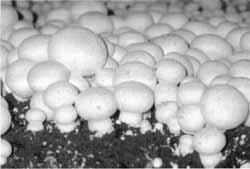Pathogenesis-Related Proteins for the Plant Protection
V. Borad, S. Sriram*
Department of Biochemistry and Biotechnology,
Institute of Science,
Nirma University of Science and Technology,
Ahmadabad (Gujarat); India
Abstract : Fungi are far more complex organisms than viruses or bacteria and can developed
numerous diseases in plants that cause loss of big portion of the crop every year. Plants have
developed various mechanisms to defend themselves against these fungi which include the
production of low molecular weight secondary metabolites, proteins and peptides having
antifungal activity. In this review, brief information like biochemistry, source, regulation of gene
expression, mode of action of defense mechanism of various pathogenesis-related proteins is
given. Proteins include pathogenesis-related protein 1, â-glucanases, chitinases, chitin binding
protein, thaumatine like protein, glycine-histidine rich proteins, ribosome inactivating protein,
and some newly discovered antifungal proteins.
Key words : Pathogenesis-related Proteins, â-Glucanase, Chitinases, Thaumatine like protein,
Glycine-histidine rich proteins and Ribosome inactivating protein.
granulomatous disease, severe combined
Introduction
immunodeficiency, chronic mucocutaneous
Fungi are an extremely diverse group of
organisms, with about 250,000 species widely
candidacies,
hyper-IgE
syndrome,
myeloperoxidase deficiency, leukocyte
distributed in essentially every ecosystem. They
can use almost any surface e.g., bathroom tile,
skin, or leaves for their growth. They are
proficient at colonizing and using plants,
humans, and animals as substrates.
During the past two decades, invasive
fungal infections have emerged as a major
threat to immunocompromised hosts. Fungal
infections are a frequent cause of death among
immunocompromised patients, and the
increasing number of immunosuppressed
patients has spurred development of new
antifungals (Shoham and Levitz, 2005). Patients
with primary immunodeficiencies exhibit
immune deficits that confer increased
susceptibility to fungal infections. Numerous
fungi, have been invariably implicated in
causing disease in patients with chronic
adhesion deficiency, defects in the interferon-
ã/interleukin-12 axis, DiGeorge syndrome, X-
linked hyper-IgM syndrome, Wiskott-Aldrich
syndrome and common variable
immunodeficiency (Antachopoulos et al.,
2007). Unfortunately there are few species
of fungi that infect the human and animals.
But among the all microbes fungi are the most
causative agent of disease in plant.
When a pathogen attacks a plant, it either
successfully infects the plant or plant prevents
the infection. Plants do not have circulating or
phagocytic cells. Instead their cells have a
thick, complex wall that acts as a barrier to
invasion. Plants display an innate pathogen-
specific resistance by producing responses like
oxidative burst of cell, change of cell wall
composition that prevent infection and de-novo
* Corresponding author : Dr. Sriram Seshadri, Department of Biochemistry & Biotechnology, Institute
of Science, Nirma University of Science and Technology, Ahmadabad, Gujarat; Ph.: +91-2717-241901
Extn. 618/627 (O); Fax: : +91-2717-241916; E-mail: sriramsjpr@gmail.com, sriramsjpr@rediffmail.com
189![]()

![]()
![]()
![]()
![]()
![]()
![]()
![]()
![]()
![]()
![]()
![]()
![]()
![]()
![]()
![]()
![]()
![]()
![]()
![]()

![]()
Borad V. and Sriram S. (2008) Asian J. Exp. Sci., 22(3), 189-196
synthesis of compounds like phytoalexin and
pathogenesis-related proteins. All this
responses can be triggered by exposing the
plant to virulent, avirulent, and nonpathogenic
microbes, or artificially with low molecular
weight and sometimes volatile molecules like
such as salicylic acid, jasmonate (Delaney et
al., 1994; Xu et al., 1994; Wu and Bradford,
2003), 2,6-dichloro-isonicotinic acid or
benzo(1,2,3) thiadiazole-7-carbothioic acid S-
methyl ester(BTH) (Vallad and Goodman,
2004). These types of resistance are called as
Systemic Acquired Resistance (SAR) or
Induced Systemic Resistance (IAR). Among
all induced responses, production of
“Pathogenesis Related (PR) proteins” is most
important because they can lead to the
increased resistance of the whole plant against
a pathogenic attack (Adrienne and Barbara,
2006). Large numbers of small, basic, cysteine-
rich antimicrobial proteins are produced by
many organisms throughout all kingdoms. They
display a great variety in their primary
structure, in species specificity, and in the
mechanism of action (Leiter et al., 2005).
There are more than 13 different pathogenesis-
related proteins are known to us.
Antifungal PR proteins are of great
biotechnological interest because of their
potential use as food and seed preservative
agents and for engineering plants for resistance
to phytopathogenic fungi (Dempsey et al.,
1998). Various studies have revealed that
transgenic plants over expressing genes of the
PR-1, PR-2, PR-3, and PR-5 families mediate
host plant resistance to phytopathogenic fungi.
Co-expression of multiple antifungal protein
genes in transgenic plants seems to be more
effective than expression of single genes
(Bormann et al., 1999).
Pathogenesis-related (PR) protein 1
The first PR- 1 protein was discovered in
1970. Since then, a number of PR-1 proteins
have been identified in Arabidopsis, Hordeum
vulgare (barley), Nicotiana tabacum
190
(tobacco), Oryza sativa (rice), Piper longum
(pepper), Solanum lycopersicum (tomato),
Triticum sp. (wheat) and Zea mays (maize)
(Liu and Xue, 2006). These PR-1 having 14 to
17 kD molecular weight and mostly of basic
nature. Non-expressors of Pathogenesis-
Related Genes1 (NPR1) regulate systemic
acquired resistance via regulation pathogenesis-
related 1 (PR-1) in Arabidopsis thaliana. The
interaction of nucleus-localized NPR1 with
TGA transcription factors, after reduction of
cysteine residues of NPR 1 by salicylic acid
(SA) results in the activation of defense genes
of PR-1. In the absence of TAG 2 and/or SA
expression of PR-1 not occur in Arabidopsis
thaliana (Després et al., 2000; Rochon et al.,
2006). PR-1 proteins have antifungal activity
at the micromolar level against a number of
plant pathogenic fungi, including Uromyces
fabae, Phytophthora infestans, and Erysiphe
graminis (Niderman et al., 1995). The exact
mode of action of the antifungal activities of
these proteins are yet to be identified but a
PR-1-like protein, helothermine, from the
Mexican banded lizard have been found to be
interacting with the membrane-channel
proteins of target cells, inhibiting the release
of Ca 2+ (Monzingo et al, 1996).
â-Glucanase (PR2):
Plant ß-1,3-glucanases (ß-1,3-Gs)
comprises of large and highly complex gene
families involved in pathogen defense as well
as a wide range of normal developmental
processes. ß-1,3-Gs have molecular mass in
the range from 33 to 44 kDa (Hong and Meng,
2004; Saikia et al., 2005). These enzymes have
wide range of isoelectric pH. Most of the basic
â-1,3-Gs are localized in vacuoles of the plant
cells while the acidic ß-1,3-Gs are secreted
outside the plant cell. Wounding, hormonal
signals like methyl jasmonate and ethylene (Wu
and Bradford, 2003), pathogen attack like
fungous Colletotrichum lagenarium (Ji and
Ku, 2002) and some fungal elicitors releases
from pathogen cell wall (Boller, 1995) can also
induced â-1,3-Gs in the various parts of plant
Pathogenesis-Related Proteins for the Plant Protection
(Wu and Bradford, 2003; Saikia et al., 2005).
The enzyme â-1,3-Gs was found to be strongly
induced by ultraviolet (UV-B; 280–320 nm)
radiation in primary leaves of French bean
(Phaseolus vulgaris), so that UV-induced
DNA damage is a primary step for the induction
of â-1,3-Gs.(Kucera et al., 2003). â-1,3-
glucanases and chitinases are down regulated
by combination of auxin and cytokinin while
Abscisic acid (ABA) at a concentration of 10
µM markedly inhibited the induction of â-1,3-
glucanases but not of chitinases (Rezzonico,
1998; Wu et al., 2001). These enzymes are
found in wide variety of plants like Arachis
hypogaea (peanut), Cicer arietinum
(chickpea), Nicotiana tabacum (tobacco), etc.
and having resistivity against various fungi like
Aspergillus parasiticus, A. flavs, Blumeria
graminis, Colletotrichum lagenarium,
Fusarium culmorum, Fusarium oxysporum,
fusarium udum, Macrophomina phaseolina
and Treptomyces sioyaensis (Rezzonico, 1998;
Wu and Bradford, 2003; Hong and Meng,
2004; Wróbel-Kwiatkowska et al., 2004, Liang
et al., 2005; Roy-Barman et al., 2006). â-1,3-
glucanases are involves in hydrolytic cleavage
of the 1,3-â-D-glucosidic linkages in â-1,3-
glucans, a major componant of fungi cell wall
(Simmons, 1994; Høj and Fincher, 1995). So
that cell lysis and cell death occur as a result
of hydrolysis of glucans present in the cell wall
of fungi.
Chitinases (PR3)
Most of Chitinase having molecular mass
in the range of 15 kDa and 43 kDa. Chitinase
can be isolated from Cicer arietinum
(chickpea) (Saikia et al., 2005), Cucumis
sativus (cucumber), Hordeum vulgare
(barley) (Kirubakaran and Sakthivel, 2006),
Nicotiana tabacum (tobacco) (Pu et al.,
1996), Phaseolus vulgaris (black turtle bean)
(Chu and Ng, 2005), Solanum lycopersicum
(tomato) (Wu and Bradford, 2003) and Vitis
vinifera (grapes) (Sluyter et al., 2005).
Chitinases can be divided into two categories:
Exochitinases, demonstrating activity only for
191
the non-reducing end of the chitin chain; and
Endochitinases, which hydrolyse internal â-1,4-
glycoside bonds. Many plant endochitinases,
especially those with a high isoelectric point,
exhibit an additional lysozyme or lysozyme like
activity (Collinge et al., 1993; Brunner et al.,
1998; Schultze et al., 1998; Subroto et al.,
1999). Chitinase and â-1,3-Glucanase are
differentially regulated by Wounding, Methyl
Jasmonate, Ethylene, and Gibberellin.
Wounding and methyl jasmonate induces gene
chi 9 for Chitinases expression in the tomato
seeds (Wu and Bradford, 2003). In some study,
it is also found that Chitinase gene are also
expressed in response to stress like cold up to
-2 to -5ºC (Yeh et al., 2000). These Chitinases
have significant antifungal activities against
plant pathogenic fungi like Alternaria sp. For
grain discoloration of rice, Bipolaris oryzae
for brown spot of rice, Botrytis cinerea for
blight of Tobacco, Curvularia lunata for leaf
spot of clover, Fusarium oxysporum, F. udum,
Mycosphaerella arachidicola, Pestalotia
theae for leaf spot of tea and Rhizoctonia
solani for sheath blight of rice (Chu and Ng
2005; Saikia et al., 2005; Kirubakaran and
Sakthivel, 2006). The main substrate of
Chitinases is chitin - a natural homopolymer of
â-1,4- inked N-acetylglucosamine residues
(Kasprzewska, 2003). The mode of action of
PR-3 proteins is relatively simple i.e. Chitinases
cleaves the cell wall chitin polymers in situ,
resulting in a weakened cell wall and rendering
fungal cells osmotically sensitive (Jach et al.,
1995).
Chitin Binding Protein (CBP, PR4):
All chitin binding proteins do not possess
antifungal activities. CBP can be isolate from
plant Beta vulgaris (suger beat), Hydrangea
macrophylla (hortensia), Nicotiana tabacum
(tobacco), Piper longum (pepper), Solanum
lycopersicum (tomato) and Solanum
tuberosum (potato) and bacteria like
Streptomyces tendae (Nielsen et al., 1997;
Bormann et al., 1999; Lee et al., 2001, Yang
and Gong, 2002,). Moleculer weight of the
Borad V. and Sriram S. (2008) Asian J. Exp. Sci., 22(3), 189-196
CBP was found to be in the range of 9 kDa to
30 kDa and having basic isoelectric pH
(Nielsen et al., 1997; Bormann et al., 1999;
Yang and Gong, 2002,) Expression of the
CACBP1 chitin-binding protein isolated from
cDNA library of pepper (Capsicum annuum
L.) (CACBP1) gene was rapidly induced in
the incompatible interactions upon pathogen
infection, ethephon, methyl jasmonate or
wounding (experimental model plant pepper).
The CACBP1 gene was organ-specifically
regulated in plants. High level of expression
occurs in phloem of vascular bundles in leaves
of pepper (Lee et al., 2001; Wan et al., 2008).
CBP shows strong inhibitory effect against
fungi Aspergillus species, Cercospora
beticola, Xanthomonas campestris and many
more and several crop fungal pathogen
(Nielsen et al., 1997; Bormann et al., 1999;
Lee et al., 2001; Yang and Gong, 2002).
Enzymeticaly CBP has not any function but it
binds to insoluble chitin and enhances hydrolysis
of chitin by other enzyme like Chitinase
(Houston et al., 2005; Vaaje-Kolstad et al.,
2005).
Thaumatin-Like Protein (TLP, PR5):
Thaumatin-like proteins comprise of
polypeptides classes that share homology with
thaumatin, sweet protein from
Thaumatococcus danielli (Bennett) Benth
(Cornelissen et al., 1986). Thaumatin-like
proteins can be isolated from Hordeum
vulgare (barley), Actinidia deliciosa
(kiwifruit), Zea mays (maize), Pseudotsuga
menziesii (douglas-firs), Nicotiana tabacum
(tobacco), Solanum lycopersicum (tomato)
and Triticum sp. (wheat) (Wurms et al., 1999;
Fecht-Christoffers et al., 2003; Anand et al.,
2004; Zamani et al., 2004). Most of the TLPs
have a molecular weight in the range of 18
kDa to 25 kDa and have a pH in the range
from 4.5 to 5.5 (Fecht-Christoffers et al., 2003;
Zamani et al., 2004). Constitutive levels of
Thumatin-Like Protein is typically absent in
healthy plants, with the proteins being induced
exclusively in response to wounding or to
192
pathogen attack like Uncinula necator,
Phomopsis viticola (Monteiro et al., 2003).
Although the specific function of many PR5 in
plants is unknown, they are involved in the
Acquired Systemic Resistance and in response
to biotic stress, causing the inhibition of hyphal
growth and reduction of spore germination,
probably by a membrane permeabilization
mechanism and/or by interaction with pathogen
receptors (Thompson et al., 2007). Linusitin is
a 25-kDa Thaumatin-Llike Protein isolated
from flax seeds. Linustin shows antifungal
activity against Alternaria alternata by the
mechanism of membrane permeabilization.
Concentration of protein and lipid and
composition of cell wall of fungi play a major
role in these mechanisms (Anzlovar et al.,
1998). In one study by Menu-Bouaouiche et
al., (2003), Thaumatin-like proteins were
isolated from cherry, apple and banana shows
antifungal activity against Verticillium albo-
atrum and having endo- â1,3-glucanase
activity.
Glycine-Histidine Rich Protein
Many insects like holotrichin and flesh fly
synthesized some Glycine-Histidine Rich
Antifungal Proteins. The mode of action of this
protein is not understood completely.
Phenoloxidase Interacting Protein (POIP)
isolated from Tenebrio molitor (Tenecin)
interacts with phenoloxidase (Yoo et al., 2001)
and inhibits some fungi like Candida albicans
and Saccharomyces cerevisiae (Kim et al.,
2001) and bacteria like Bacillus subtilis,
Proteus vulgaris and Streptococcus aureus
(Kim et al., 2001).
Ribosome Inactivating Protein (RIP,
PR10)
RIP has an inherent antifungal activity. It
has been isolated from Arachis hypogaea L.
(peanut), Mirabilis expansa (mauka)
(Vivanco et al., 1999), Nicotiana tabacum
(tobacco) (Kim et al., 2001), Pisum sativum
(pea) (Ye et al., 2000), Solanum surattense
(nightshade) and Volvariella volvacea
.




